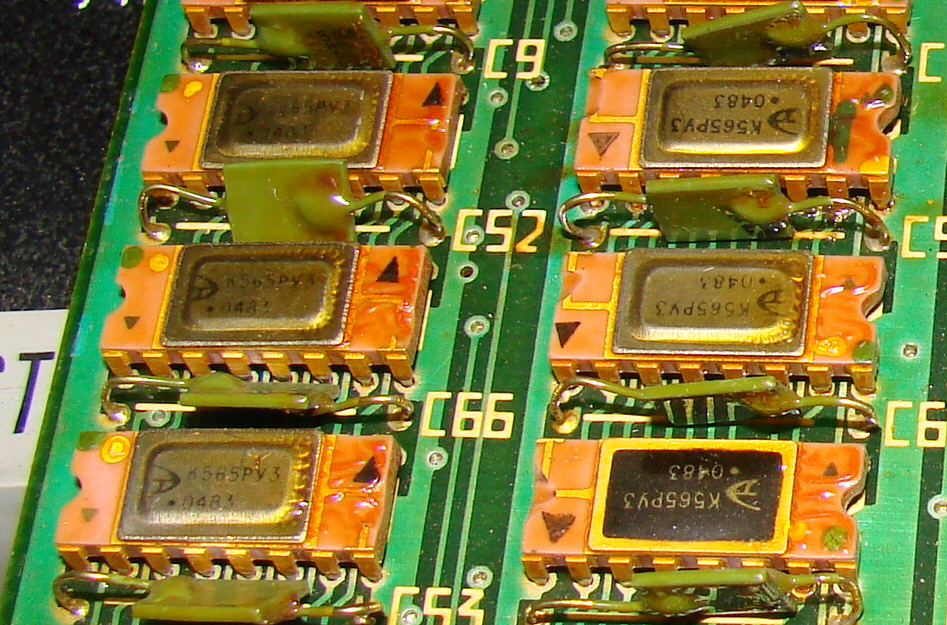565РУ3А
565РУ3, 565РУ3А, 565РУ3Б, 565РУ3В, 565РУ3Г
DRAM 16kx1
Description
K565RU3 is an electronic component, a dynamic random access RAM chip with a capacity of 16384 bits and an organization of 16384x1. Designed for storing information (programs and data) in microprocessor devices. Supply voltages - +5 V, +12 V, -5 V. Housing type - 201.16-5 (CDIP16). The microcircuit was manufactured using n-MOS technology and had sufficient speed for use with contemporary microprocessors. The first releases used a 10 mm wide ceramic case, then, to better match the prototype, the case width was reduced to 7.5 mm (4116 has 0.3 inches, or 7.62 mm). Unlike the prototype, K565RU3 was not mass produced in a plastic case. There was a version of the chip labeled K581RU4, which was formally part of the K581 microprocessor kit, which was a copy of the DEC chips that made up the LSI-11/23 processor. It is not known whether there was any difference between the crystals of microcircuits marked K565RU3 and K581RU4; in the P2 boards of the Electronics-60 computers they were interchangeable.
The chip uses address bus multiplexing to reduce the number of pins on the package. The address is transmitted to the chip in two steps, using the row address sampling signals (Row Address Strobe, RAS) and column address sampling signals (Column Address Strobe, CAS), respectively. To perform recording, the write enable signal (Write Enable, WE) is used.
Unlike its predecessors, the K565RU3 microcircuit does not require a high-voltage clock signal; all control inputs are TTL compatible. The active level of all control signals is low (logical “0”>). The input and output of the microcircuit in small systems can be combined. An eight-bit device requires a multiple of 8 chips.
Before K565RU3, dynamic RAM chips used three-transistor cells, which provided a 2-fold savings in chip area compared to static RAM, where 6 transistors were required per cell. K565RU3 was the first mass-produced microcircuit to use a single-transistor cell. This made it possible, using the same design standards, to move on to the production of microcircuits with four times more capacity, so only 2 years passed between the development of K565RU1 with a capacity of 4096 bits and K565RU3. The use of a single-transistor cell requires a more complex amplifier-comparator circuit, since the charge transferred to the column bus becomes much smaller, in addition, due to the increase in the number of cells in the column, the bus capacity increases. Once these difficulties were overcome, the three-transistor cell was no longer used.
Regeneration of the contents of the RAM is carried out by applying a RAS signal and searching through all 128 possible address states; the regeneration period should not exceed 2 milliseconds. This is typical for first generation devices. When using such microcircuits in video controllers, where the image on the screen had to be updated 50-60 times every second, regeneration was “free”, but if used as the “main” RAM, regeneration reduced the system performance by a few percent. Some systems used tricks that allowed regeneration to occur while the microprocessor was not accessing RAM.
The production of the microcircuit began in 1979, and by the time a series of articles about microprocessor technology appeared in the Radio magazine (1983), it had become widespread.
Despite the fact that this microcircuit used the same three supply voltages as the КР580ИК80А microprocessor, it was much more critical to the loss of negative substrate bias - even with interruptions of 20 ms, the microcircuits failed. Another feature was strong interference along the power lines, due to changes in current consumption when reading or writing information, which required the installation of blocking capacitors of a relatively large capacity on each chip.
K565RU3 was soon supplanted by later versions of К565РУ5 (analog of 4164) and К565РУ6 - they used only +5 V power and were much less likely to fail, and K565RU5 chips also had a larger capacity - 65536 bits. New types of microcircuits were already produced in a plastic case (in this case they were called KR565RU5 or KR565RU6), their crystal had smaller dimensions.
The К565РУ7 microcircuit, released in the second half of the 80s, had a capacity of 262144 bits, but was not an analogue of 41256 due to a different regeneration scheme.
Pin assignment
| Pin | Designation | Pin type | Description |
|---|---|---|---|
| 1 | Uss | - | -5 V, negative substrate bias voltage |
| 2 | DIN | Input | Write data input |
| 3 | WE# | Input | Input Signal <Recording Enable> |
| 4 | RAS# | Input | Input Signal <Address strobe lines> |
| 5 | A0 | Input |
Input Signal <Address 0> |
| 6 | A2 | Input | Input Signal <Address 2> |
| 7 | A1 | Input | Input Signal <Address 1> |
| 8 | Ucc2 | - | Supply voltage +12 V |
| 9 | Ucc1 | - | Supply voltage +5 V |
| 10 | A5 | Input | Input Signal <Address 5> |
| 11 | A4 | Input | Input Signal <Address 4> |
| 12 | A3 | Input | Input Signal <Address 3> |
| 13 | A6 | Input | Input Signal <Address 6> |
| 14, | DO | Tristable output | Data output when reading |
| 15, | CAS# | Input | Input Signal <Column Address Gate> |
| 16 | GND | - | Common |
Parameters
| Parameter | 565РУ3А | 565РУ3Б | 565РУ3В | 565РУ3Г | |
|---|---|---|---|---|---|
Power dissipation | P | <460 mW | |||
IC package | Package | 201.16-17, 2104.18-1, 201.9-1, 16-QSOP | |||
IC manufacture technology | Technology | MOS | |||
IC series | Series | 565 | |||
Logic gate family | Logic | P-MOS | |||
Query time | TQ | <300 ns | <300 ns | <250 ns | <200 ns |
Memory organization | Structure | 16k x 1 | |||
